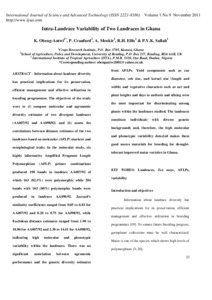| dc.contributor.author | Obeng-Antwi, K. |
| dc.contributor.author | Craufurd, Peter Q. |
| dc.contributor.author | Menkir, A. |
| dc.contributor.author | Ellis, R.H. |
| dc.contributor.author | Sallah, P.Y.K. |
| dc.date.accessioned | 2019-12-04T11:11:11Z |
| dc.date.available | 2019-12-04T11:11:11Z |
| dc.date.issued | 2011 |
| dc.identifier.citation | Obeng-Antwi, K., Craufurd, P., Menkir, A., Ellis, R.H. & Sallah, P.Y.K. (2011). Intra-landrace variability of two landraces in Ghana. International Journal of Science and Advanced Technology, 1(9), 23-40. |
| dc.identifier.issn | 2221-8386 |
| dc.identifier.uri | https://hdl.handle.net/20.500.12478/2370 |
| dc.description.abstract | Information about landrace diversity has practical implications for its preservation, efficient management and effective utilization in breeding programmes. The objectives of the study were to (i) compare molecular and agronomic diversity estimates of two divergent landraces (AA007/92 and AA098/92) and (ii) assess the correlations between distance estimates of the two landraces based on molecular (AFLP) markers and morphological traits. In the molecular study, six highly informative Amplified Fragment Length Polymorphism (AFLP) primer combinations produced 198 bands in landrace AA007/92 of which 163 (82.3%) were polymorphic while 204 bands with 163 (80%) polymorphic bands were produced in landrace AA098/92. Jaccard’s similarity coefficients ranged from 0.05 to 0.83 for AA007/92 and 0.20 to 0.75 for AA098/92, while Euclidean distance estimates ranged from 1.90 to 18.80 for AA007/92 and 2.30 to 14.41 for AA098/92, indicating high molecular and phenotypic variability within the landraces. There was no significant association between agronomic performance and the genetic diversity estimates rom AFLPs. Yield components such as ear diameter, cob size, and kernel size (length and width) and vegetative characters such as ear and plant heights and days to anthesis and silking were the most important for discriminating among plants within the landraces studied. The landraces constitute individuals with diverse genetic backgrounds and, therefore, the high molecular and phenotypic variability detected makes them good source materials for breeding for drought-tolerant improved maize varieties in Ghana. |
| dc.format.extent | 23-40 |
| dc.language.iso | en |
| dc.subject | Land Races |
| dc.subject | Zea Mays |
| dc.subject | Aflp |
| dc.subject | Variable Costs |
| dc.title | Intralandrace variability of two landraces in Ghana |
| dc.type | Journal Article |
| dc.description.version | Peer Review |
| cg.contributor.affiliation | Council for Scientific and Industrial Research, Ghana |
| cg.contributor.affiliation | University of Reading |
| cg.contributor.affiliation | International Institute of Tropical Agriculture |
| cg.coverage.region | Africa |
| cg.coverage.region | West Africa |
| cg.coverage.country | Ghana |
| cg.coverage.country | Nigeria |
| cg.authorship.types | CGIAR and developing country institute |
| cg.iitasubject | Biodiversity |
| cg.iitasubject | Land Use |
| cg.journal | International Journal of Science and Advanced Technology |
| cg.howpublished | Formally Published |
| cg.accessibilitystatus | Limited Access |
| local.dspaceid | 92279 |
| cg.targetaudience | Scientists |

